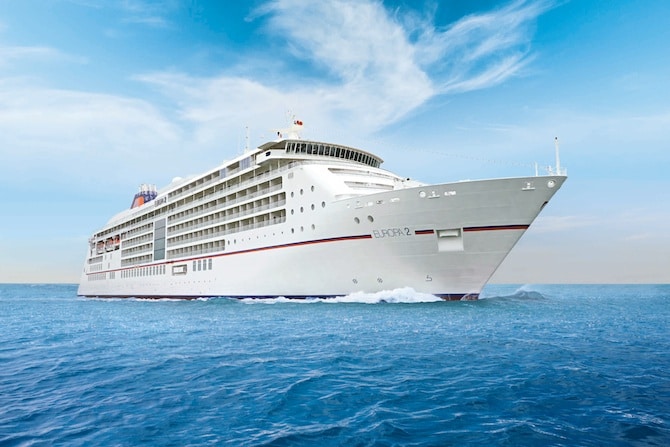
Later this year, in December 2014, the Hapag-Lloyd Cruises will launch their EUROPA 2 vessel for the United States. I was lucky enough to be invited as a guest to experience the ship for myself before the launch, journeying from Athens to Malta.
Along the way I learned much about the ship’s eco-values — they’re the first first cruise ship equipped with a Selective Catalytic Reduction (SCR) converter, which reduce the emission of nitrogen oxides by almost 95% and made me very happy as a responsible traveler — as well as their new 2015 routes through south-eastern Africa, the Mediterranean, Scandinavia, Western Europe, India, the Arabian Peninsula, Vietnam and Hong Kong. But most importantly, I savored a truly memorable food and wine experience at sea.

EUROPA 2 Owner Suite. Photo courtesy of Hapag-Lloyd.
About The Ship
Let me start off by saying the EUROPA 2 is not your average cruise ship. It’s a true luxury vessel that feels more like a 5-star hotel than a cruise. That being said, it has a laid-back feel, especially with the minimalist design, use of limestone over marble and lack of a dress code.
Yes, the price tag is higher than most cruises; however, you get what you pay for. As someone who’s cruised numerous times using popular lines like Norwegian, Carnival and Holland America, I can honestly say this ship is completely different. First of all there are eight room categories — all suites — ranging from the 301-square foot Veranda Suite to the the 1,066-square-foot Owner Suite. No matter what room you stay in, though, you’ll have an ocean-view veranda with 75-square-feet of space, bathtub, spacious shower, 24-hour suite service, portable tablet PC and cordless phone to carry anywhere on the ship and Nespresso machine.
All of the restaurants — including specialty restaurants like the sushi, French, Italian, tapas, Asian and Yacht Club eateries — are free of charge. Also complimentary is the mini bar (more on this below), spa facilities, gym, fitness classes and room service. I myself stayed in the Spa Suite, making daily use of the in-room steam sauna, whirlpool and 108-square-foot balcony with chaise lounges.
Moreover, there are only 251 rooms (a maximum of 500 passengers) for an intimate experience. While the ship caters to the luxury market, there is an undeniably relaxed feel as the EUROPA 2 is is void of dress codes and assigned restaurant seating. This ship for the wealthy isn’t the place to show off your gowns and tuxedos, but to enjoy the amenities — and flavors! — money can provide you.
1. The Mini Bar
A true highlight for someone who loves to make cocktails (like myself) is the mini bar. It comes fully stocked with Hennessy Very Special Cognac, Beefeater Gin, Bianco lo Chardonnay di Nonino Grappa and Absolut Vodka and re-stocked twice a day. Oh yea, and did I mention it’s free? This makes for some fun cocktail nights with friends — ask the on-board bartenders for some recipe suggestions — without spending a fortune.
Even if you don’t make use of the mini bar, drinks on board are reasonably priced — there were plenty of glasses of wine for around $4 and spirits starting at around $6 — a true rarity on most cheaper cruises as alcohol is where they make their money.
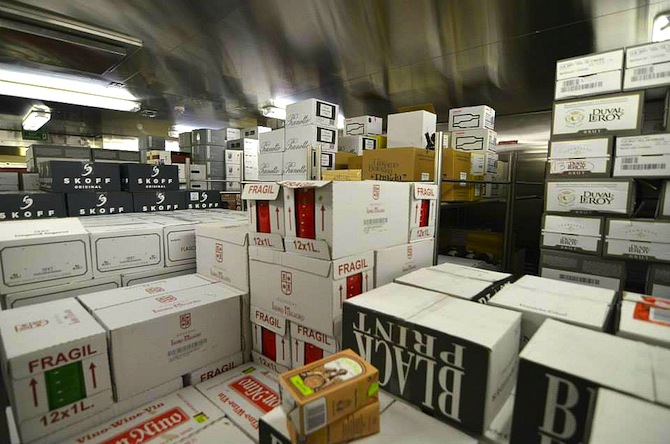
Champagne cellar aboard the EUROPA 2. Photo courtesy of Hapag-Lloyd.
2. Wine Tasting
With approximately 50 different Champagnes and 500 different wines on board — including about 50 wines by the glass — Sommelier Florian Sender has a lot of research to do (or at least a lot of drinking). The menu is focused on German whites and Italian and French reds — Old World Wines — although New World styles and wines local to the ports visited on the cruise itineraries are also part of the selection. One aim is to showcase lesser-known appellations and introduce passengers to wines they may not have heard of, for example, the Cahors Appellation, near to Bordeaux but under the radar.
Along with helping guests with meal pairings, wine tastings are held — with a maximum of 14 people to keep things intimate, as well as rotating bites like canapes, sashimi, breads, cheeses and ceviches. As Florian knows I’m crazy about wine he takes me down into the boat’s “wine cellar,” where wines and Champagnes are methodically stored. He has me sample three very different wines to showcase just how diverse the ship’s wine list really is.
We begin with a Diel Riesling Goldloch GG from Germany. The wine is made from single vineyard grapes and is limited in quantity. Pale yellow in color, dry and crisp with notes of apple and a high acidity, the wine would be excellent for food pairing, wetting the palate for the next bite. It also makes clear exactly what Rudi Eilers taught in my Germany sommelier certification course, Germany wines and Rieslings are not always sweet.
Next we move on to a 2009 Stag’s Leap Wine Cellars Arcadia Chardonnay from Napa Valley, aged in American oak and refreshingly acidic. Notes of fresh-baked apple tart, citrus and sweet spice envelop my palate, with a honeyed character presenting itself as time goes on.
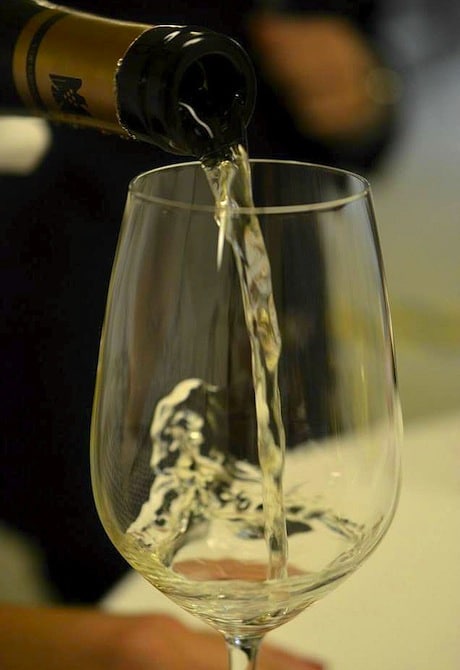
Wine tasting aboard the EUROPA 2. Photo courtesy of Jessica Festa.
Finally, we savor a wine not on the official wine list, but something Florian picked up while we were at port in Napflian, Greece, a 2012 Palirou Estate KTHMA IIAAYBOY NEMEA from Nemea in the Peloponnese. It’s beautiful, deep burgundy color with slightly browned edges. Made with 100% Agiorghitiko, it offers soft tannins and a balanced acidity. The wine is part of a program the EUROPA 2 partakes in where they’ll search for delicious local wines in each place they go to allow guests to immerse themselves in local culture through the palate. These wines are served during tastings, events and are sometimes featured as a guest wine on the menu.
Wine tastings vary in price, depending on what wines are tasted, and groups can request to have specific wines sampled and/or paired with food. For something truly decant, ask to do a Champagne pairing dinner, or dine at Tarragon with its fine French food and wines. If you’ve got money to spend, their most expensive bottles are a Krug Clos de Mesnuil ($1,360) and a 2006 Romanee-Conti St. Vivant ($1,900) — although they also sell bottles starting at about $20.
“At the end of the day the most important thing is that the guests are happy,” explains Sender. “It’s important to get to know your passengers and what they like, which is easy to do on a small ship like the EUROPA 2.”

EUROPA 2 Culinary School. Photo courtesy of Hapag-Lloyd.
3. All-natural spice sampling
“It’s all about looking at the spices, salts and oils as food. What flavors would you like to pair?”
On the EUROPA 2 they have a culinary school that offers intensive cooking classes with wine pairing as well as free-to-enjoy gourmet expert workshops. Workshop focuses can vary from quality meat education to ice cream making to cheese pairing and beyond. Today, I get to experience an oils, herbs and spices workshop, led by mother and daughter team Marina and Yvonne of Finca Marina.
“It all started with olive oil,” she smiles. “I was living in Majorca, growing herbs and spices. I visited an olive oil mill and asked them how we could work together. What we do is very special.”
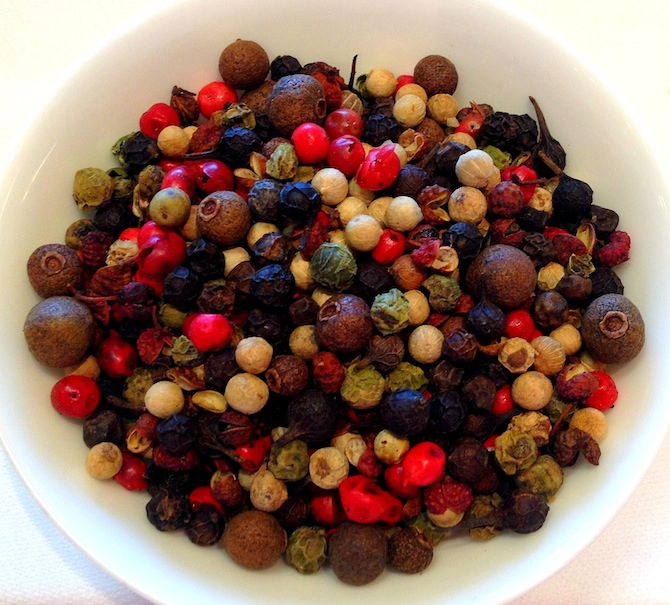
Aromatic spices during a EUROPA 2 cooking class. Photo courtesy of Jessica Festa.
As soon as I walk into the culinary school aromas of chile, hibiscus and basil infiltrates my nostrils. Despite having just ate a decadent Greek meal in Corfu, I find myself salivating. A staff member hands me a glass of bubbling Prosecco, which wets my appetite further.
A long silver table is adorned with a colorful and aromatic display of herbs, spices, peppers, chilies, nuts, oils and bread. There are all-natural ingredients from all over the world, each with a unique twist: olive oil infused with mandarin, red salt with hibiscus, almonds with mint, porcini salt — all begging to be tasted.
Marina explains to us the premise behind her business and what makes these offerings so unique. First of all, everything is all natural, with salts sourced from oceans and seas all over the world. Moreover, their olive oils are infused with fruits, vegetables and herbs that are pressed — skins and all — together with the olives. Some of the recipes she uses were her grandmother’s,
“I want to invite you all to do a tasting,” says Marina, inviting us up to the aromatic table. “Take a piece of bread and dip it one of the olive oils before topping it with the salt or herbs. I can help you create the pairing.”
It’s interesting seeing what Marina comes up with. When I ask her what her method is for creating the combinations, she explains to me with nostalgia in her voice that she used to pick mushrooms with her father for cooking, and that her grandmother also loved to cook and would involve her in it. As an adult she spent time as a chef and nurse, learning about food pairings as well as natural medicine and how different ingredients work with the body. This knowledge helps Marina to come up with the recipes, while also looking at the products as foods themselves instead of just condiments and dressings.

A whole table full of colorful spices. Photo courtesy of Jessica Festa.
“These are gourmet salts. You don’t use them for cooking. You put them on top of your food so you can taste them,” she explains.
I take a small piece of Italian bread, ready for guidance. First she recommends I try a ginger-infused olive oil with Damascus rose salt, as the rose softens the spice of the ginger while creating a complex flavor. She also suggests combining tomato-infused olive oil with basil salt, a lovely combination reminiscent of an Italian dinner. In terms of drinks, Marina has me put a strand of ancient chile into my Prosecco, which not only looks beautiful but adds a little kick to the bubbly drink.
By the end of the lesson I feel like a chef myself. Okay, so I didn’t do as much as Marina who actually pressed the oil and collected the herbs, but having a plethora of natural flavors at my disposable makes me feel like a kid reading one of those books where you can choose the different endings. Anything is possible.

Herrenzimmer Bar. Photo courtesy of Hapag-Lloyd.
4. Gin tasting
One truly unique aspect of the EUROPA 2 is their gin collection containing 32 popular and rare gins — the largest collection at sea. One can sample gin tastings and cocktails or take a gin tasting class at the on-ship Herrenzimmer Bar, also home to a humidor full of cigars (including Cubans!). These tasting experiences are complimentary, and include an aperitif gin cocktail as well as three gin tastings and an education on the mysterious spirit.
“Would you like a ‘Monkey Sloe Fizz’ to start?” asks a smiling waitress.
I nod. “What’s in it?”
“Monkey 47 Sloe Gin, lemon, sugar, soda water and a dash of Angostura Bitters. It’s very refreshing.”
I make myself comfortable on a chocolate brown leather couch in front of a fiber optic fireplace, and the waitress promptly delivers my drink. She’s right. The lemon and carbonated water give the drink life while the gin and bitters deliver earth and spice.
Erik Schutze, the EUROPA 2’s Public Room Manager, is leading the tasting, beginning with some information on exactly how to properly do a gin tasting. Apparently it’s much like a wine, where you first examine the drink’s color — the botanicals the gin contains can affect the color — and then swirl the liquid, allowing the aromas to float up toward the rim of the glass. Then, you taste, allowing the gin to wash over your palate, slide over your tongue and taste buds, and take over your senses.
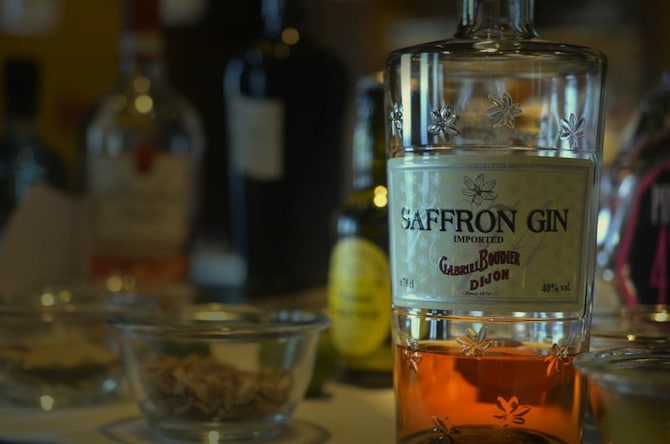
Gin tasting on the EUROPA 2. Photo courtesy of Jessica Festa.
With each tasting, we’ll first sample the gin pure to know its true essence. Next, some soda water and a garnish will be added to dilute the alcohol and allow the drinker to more fully appreciate the flavors of the gin, as well as a garnish to complement the botanicals. In front of the bar, perfectly-positioned bottles of gin are surrounded by bowls of spices and drink additions like orange peels, coriander, ginger, thyme and mint. What’s interesting to me is how lemon zest doesn’t always need to be the garnish for a gin cocktail — there’s an entire world of flavor enhancers out there.
We begin the tasting with a “50 Pounds Gin” from England’s Thames Distillers, distilled four times for a full-bodied gin with balanced essences of juniper, spices and citrus. Schutze serves it with an orange peel, adding a slight zesty sweetness.
Next, a rare “Monkey 47 – Schwarzwald Dry Gin” — only 1,000 bottles are made each year — by Black Forest Distillers in Germany is served. This gin contains 47 different botanicals, like honeysuckle, fir and slow, hand-picked from Germany’s Black Forest. The gin, which is made using an old family recipe, is aged for 100 days in an earthware container before being diluted. It’s more fruity than the first — with a black pepper finish — and is also served with an orange peel twist. Interestingly, Schutze tells us the quintessential at sea cocktail is the Gin & Tonic, and the Monkey 47 is the most popular gin aboard the EUROPA 2 for the drink.
We finish with a “Darnley’s View Spiced London Dry Gin” from Wemyss Malts in London, traditionally distilled five times in a pot-still process. In this gin 10 different botanicals are included: cinnamon, ginger, nutmeg, cassia, cumin, juniper, Guinea pepper, clove, coriander and angelica root. With one sniff I’m immediately transported to Christmastime, cinnamon, clove and other sweet spices floating up into my nostrils. Once the tonic water and a slice of ginger is added, the drink is softened and the botanicals are easier to identify.

The Grande Reserve aboard the EUROPA 2. Photo courtesy of Hapag-Lloyd.
5. The Grande Reserve
While there are seven restaurants on board, each with their own unique offerings, for me the most special was the Grande Reserve, described by the EUROPA 2 as “the place where connoisseurs and new wine lovers meet to indulge in their passion for fine wine.”
The special space actually shares the same menu as the ship’s French restaurant, Tarragon; however, it is the private atmosphere that takes this venue to the next level. This is the type of venue where dinner lasts four hours, with apertifs, a variety of fresh-baked breads, a trolly of starters, multiple courses, decadent desserts and, of course, wine pairings.
As soon as I walk in to the cozy space, sunlight pouring in through large glass windows and a perfectly laid-out table of wine classes and fine Dibbern crockery, I’m handed an apertif of Duval-Leroy Champagne, the bubbles energetically dancing up the sides of the glass. I mingle with the other guests, chatting about the day’s shore excursions and our plans for the upcoming ports. An impressive selection of breads gets passed around, with delicious Parmesan-thaler and brioche to top with salted and unsalted butter and cabbage dips.
I’m brought an innovative amuse-bouche of asparagus sorbet topped with chili, a unique take on sweet and savory, as a server sidles up behind me.
“Would you like to choose a starter from the trolley?” asks one of our servers — there are about six for our group of 12.
He holds out a tray of tasty selections: shrimp and chicken terrine with tarragon-aioli and saffron pear; marinated salmon with melon confit and caviar; goat cheese mousse with herbs of Provence and rosemary biscuits; and marinated pulpo with candied tomatoes and parsley. I choose the terrine, which offers an effusive mix of sweet, savory and spicy in just a few bites.

Seafood soup at Grande Reserve. Photo courtesy of Jessica Festa.
We’re still not done with the appetizers, as these were just the selection from the cart. Some others include a freshly prepared beef tartar; a mushroom and leek consume with chervil dumplings; a white bean soup with pistou (French pesto) and croutons; cod fish brandade with truffle and smoked bell pepper; and, my selection, a prawn and scallop pot-au-feu with marinated lemon, which is served as a fresh seafood soup, clean meat mixing with zesty citrus.
To pair with our starters we are poured a 2011 Chablis Premier Cru, Montmains wine from Burgundy, France. It’s a very light, clean wine with a floral essence that goes well with the seafood I’ve chosen. Of course, I’m free to choose a different wine from the list of 500 wines; however, I’m delighted with the choice.
Choosing a main is a difficult choice, and while I’m welcome to order as mainly entrees as I’d like I decide to hold back, if only to preserve my figure. I notice almost all of the dishes listed have wine infused into the recipe — a typical French cooking method as the alcohol vaporizes yet the flavor remains — like fried turbot with Beurre Blanc, beetroot and cauliflower; sauteed lobster with Muscat pumpkin and morrels; and cepes mushroom layers with potatoes and Beurre Rouge. In the end, I opt for the “Entrecote Double” with butter Cafe de Paris, leaf spinach and potato gratin. The dish is a thick steak, the entire slab of beef brought tableside and cut right in front of me, the knife cutting the tender meat like butter, the pinkish slices falling gracefully to their side before being delicately gowned in gravy.
I can’t help but notice that when each course is served it’s like a dance, with the servers putting one hand behind their back and placing the dishes at the very same time, counting down like it’s a performance.

“Entrecote Double” aboard the EUROPA 2. Photo courtesy of Jessica Festa.
For this course I switch to red wine, the sommelier recommending a 2009 Chateau Faugeres Grand Cru from the St. Emilion region of Bordeaux. The wine is medium bodied with a strawberry nose, luscious tannins and flavors of plum, juicy fruit and a slight spice finish. For me, the marriage of fine French wine and fine French food is heavenly, changing the dinner from a meal to an experience.
While at this point everyone is full, there’s still dessert to think about. The selections are of course of French origin, including a chilled blood peach soup with pistachio parfait; moelleux au chocolat with carmelized tarragon-pineapple and vanilla ice cream; and quince tart with black currant and lavender honey mousse.

Grande Reserve dessert. Photo courtesy of Jessica Festa.
I sit and stare out the window, my eyes taking in the ocean scenery. And as the waves spill out over the ocean, chocolate pours over my tongue. Like the refreshing feeling that takes you over when you jump into the cold water, I’m awakened by the acidity of the pineapple, cooled down by the mint. It’s a truly decadent experience aboard a truly decadent ship.
Top photo MS EUROPA 2. Photo courtesy of Hapag-Lloyd.

Jessica Festa is the editor of the travel sites Jessie on a Journey (http://jessieonajourney.com) and Epicure & Culture (http://epicureandculture.com). Along with blogging at We Blog The World, her byline has appeared in publications like Huffington Post, Gadling, Fodor’s, Travel + Escape, Matador, Viator, The Culture-Ist and many others. After getting her BA/MA in Communication from the State University of New York at Albany, she realized she wasn’t really to stop backpacking and made travel her full time job. Some of her most memorable experiences include studying abroad in Sydney, teaching English in Thailand, doing orphanage work in Ghana, hiking her way through South America and traveling solo through Europe. She has a passion for backpacking, adventure, hiking, wine and getting off the beaten path.








